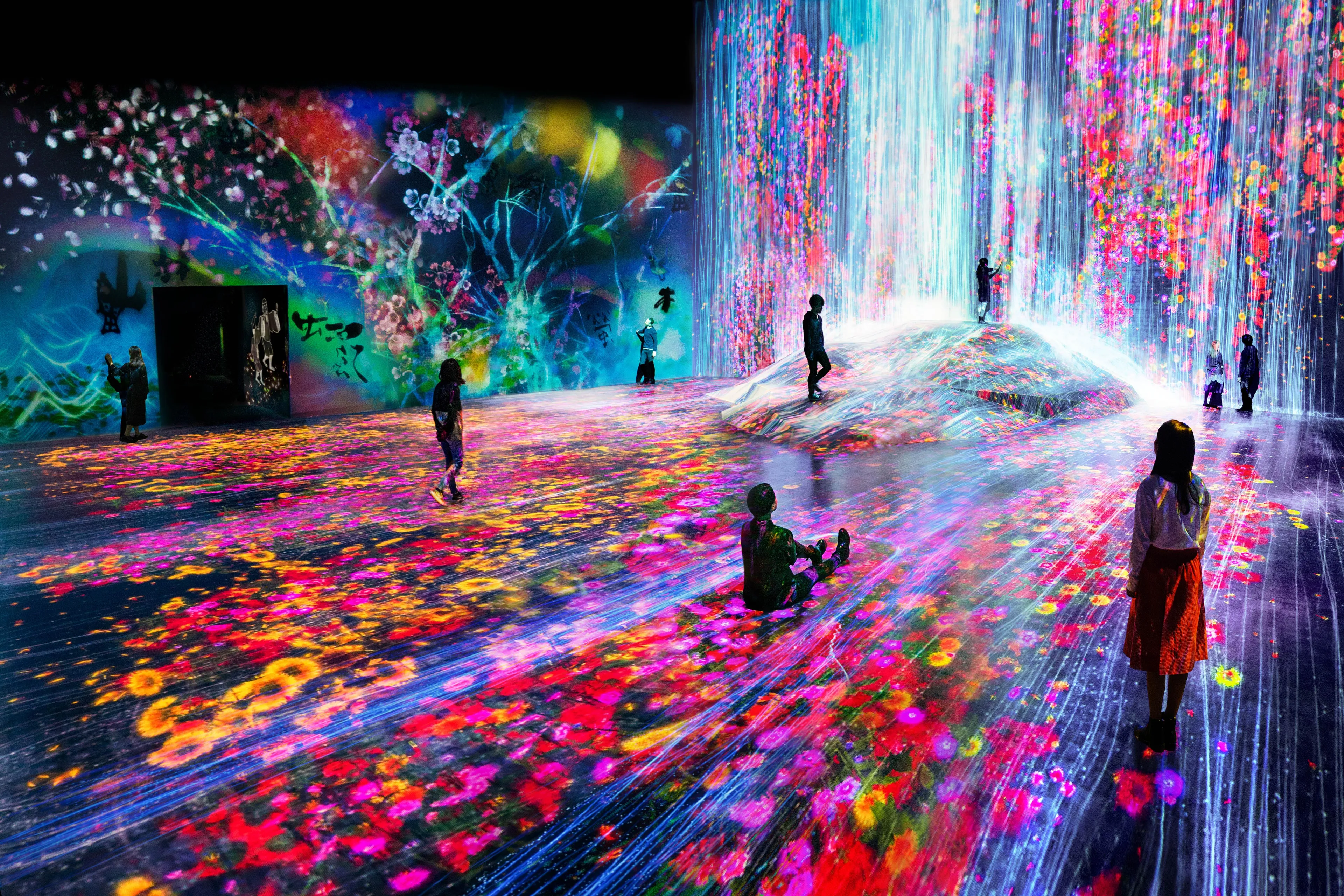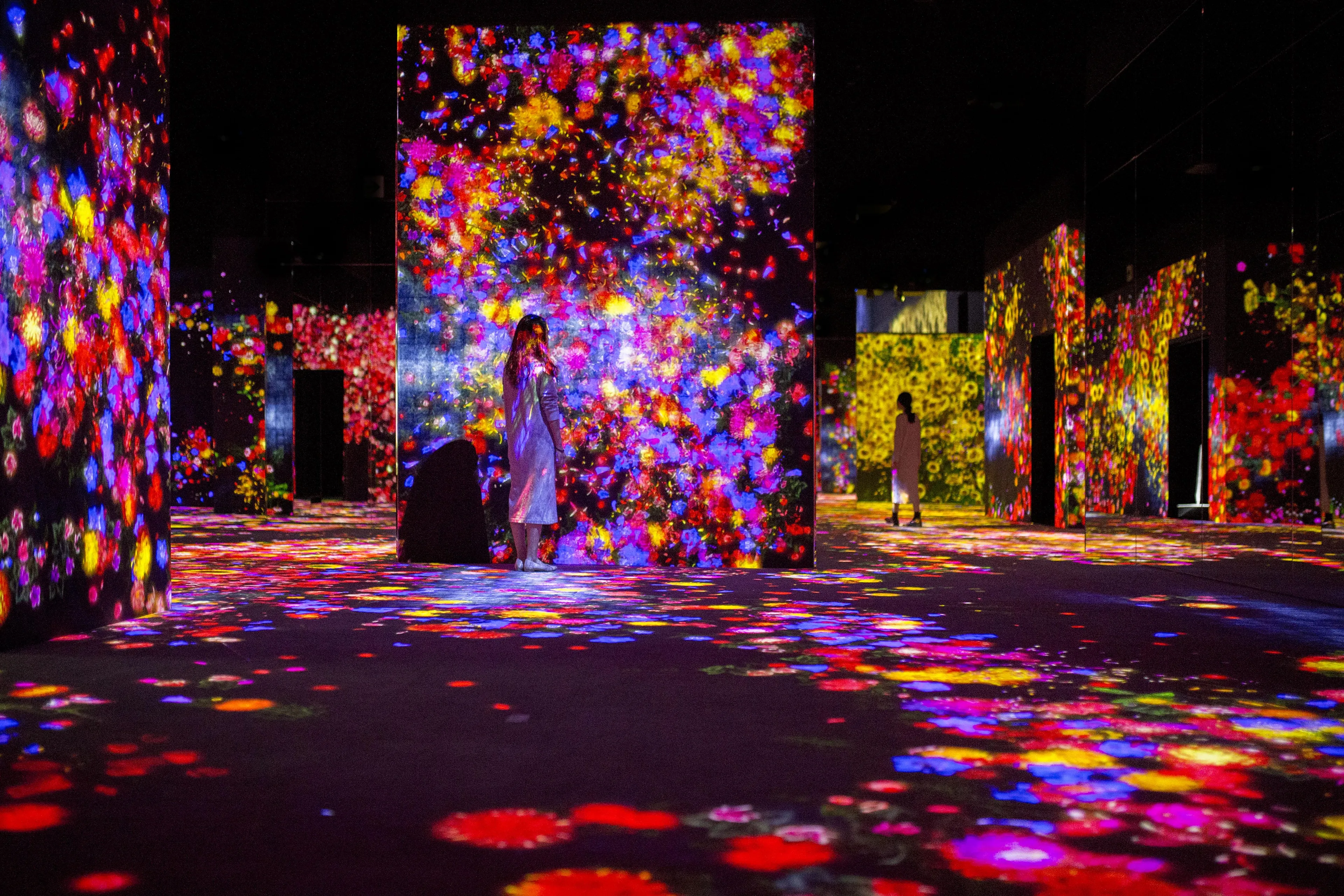
FEATURED WORKS

Black Waves: Lost, Immersed and Reborn
teamLab, 2019, Digital Installation, Continuous Loop, Sound: Hideaki Takahashi
This is an installation made of one continuous wave. The waves projected are all connected and form a single, unbroken body of water. As we immerse and meld ourselves into the waves, we explore a continuity among people, as well as a new relationship that transcends the boundaries between people and the world.
The movement of waves in water is simulated in a computer-generated three-dimensional space. The water is expressed as a continuous body after calculating the interactions of hundreds of thousands of particles. To visualize the waves, the behavior of the particles of the water was then extracted and lines were drawn in relation to the movement of the particles. The wave created in a 3-D space is then turned into an artwork in accordance with what teamLab refers to as ultrasubjective space.
In premodern Japanese painting, oceans, rivers, and other bodies of water were expressed as a series of lines. These lines give the impression of life, as though water was a living entity.
This form of expression leads us to question why premodern people sensed life in rivers and oceans. Also, why did they behave as if they themselves were a part of nature? Perhaps something can be discovered by fusing the fixed objective world of today’s common knowledge with the subjective world of premodern people.
While viewing this artwork, if we feel a sense of life in the collection of lines—what can be called the subjective world of premodern people—then perhaps this is one aspect of objective recognition.
When viewing this artwork, as opposed to watching waves shot with a video camera, people may feel that the barrier between themselves and the waves disappears. They feel immersed in the work, perhaps even feeling life in the collection of lines, as if the waves are luring them in. Perhaps we can find a connection to the way premodern Japanese people perceived the world and consequently behaved toward the world.
If we regard ourselves as a part of nature, and consider nature not just as something to be observed, we might join premodern people in perceiving rivers and oceans as living entities. This is a way of seeing the world that lures us in and allows us to feel that there is no boundary between ourselves and nature.

Flowers and People, Cannot be Controlled but Live Together – A Whole Year per Hour
teamLab, 2014-, Interactive Installation, Endless, Sound: Hideaki Takahashi
공간 속에 여러 계절이 동시에 존재하며 그 계절들이 천천히 변화 해간다.
꽃들은 움직이는 계절을 따라서 피어나는 장소도 천천히 이동한다.
꽃들은 태어나, 성장해, 꽃망울을 맺히고, 꽃을 피우고, 이윽고 꽃잎을 떨구고, 시들어 죽어간다. 즉, 꽃은 탄생과 사멸을 영원히 반복하고 있다. 사람들이 가만히 있으면 주변에 꽃들이 평소보다 많이 태어나고 피어나간다. 사람들이 꽃을 만지거나 밟으면 한꺼번에 흩어져 죽어간다.
봄에 구니사키반도를 방문했을 때, 산 속의 벚꽃과 산기슭의 유채꽃을 바라보며, 어디까지가 사람이 심은 것인지, 어디까지가 자생하는 꽃들인지 의문이 들었다. 그곳은 많은 꽃들에 둘러싸여, 아주 기분이 편하고 좋은 장소였다. 그리고, 그 자연이 사람의 활동에 영향을 받은 생태계라는 것을 느끼게 한다. 어디까지가 자연이고 어디부터가 인위적인가, 경계가 매우 애매하다. 즉, 자연과 인간은 대립하는 개념이 아니며, 기분 좋은 자연이란, 사람의 활동을 포함한 생태계인 것이다. 그리고, 지금과는 달리, 자연을 이해하거나 제어할 수 없어 자연의 규칙을 따르던 사람들의 활동이 이 기분 좋은 자연을 만든게 아닌가. 계곡 사이에 있던 동네에는, 옛적의 자연과 사람의 관계가 희미하게 남아있는 것처럼 느껴, 자연을 제어할 수 없을 때에 자연에 대한 인위는 무엇인가, 모색하려 한다.
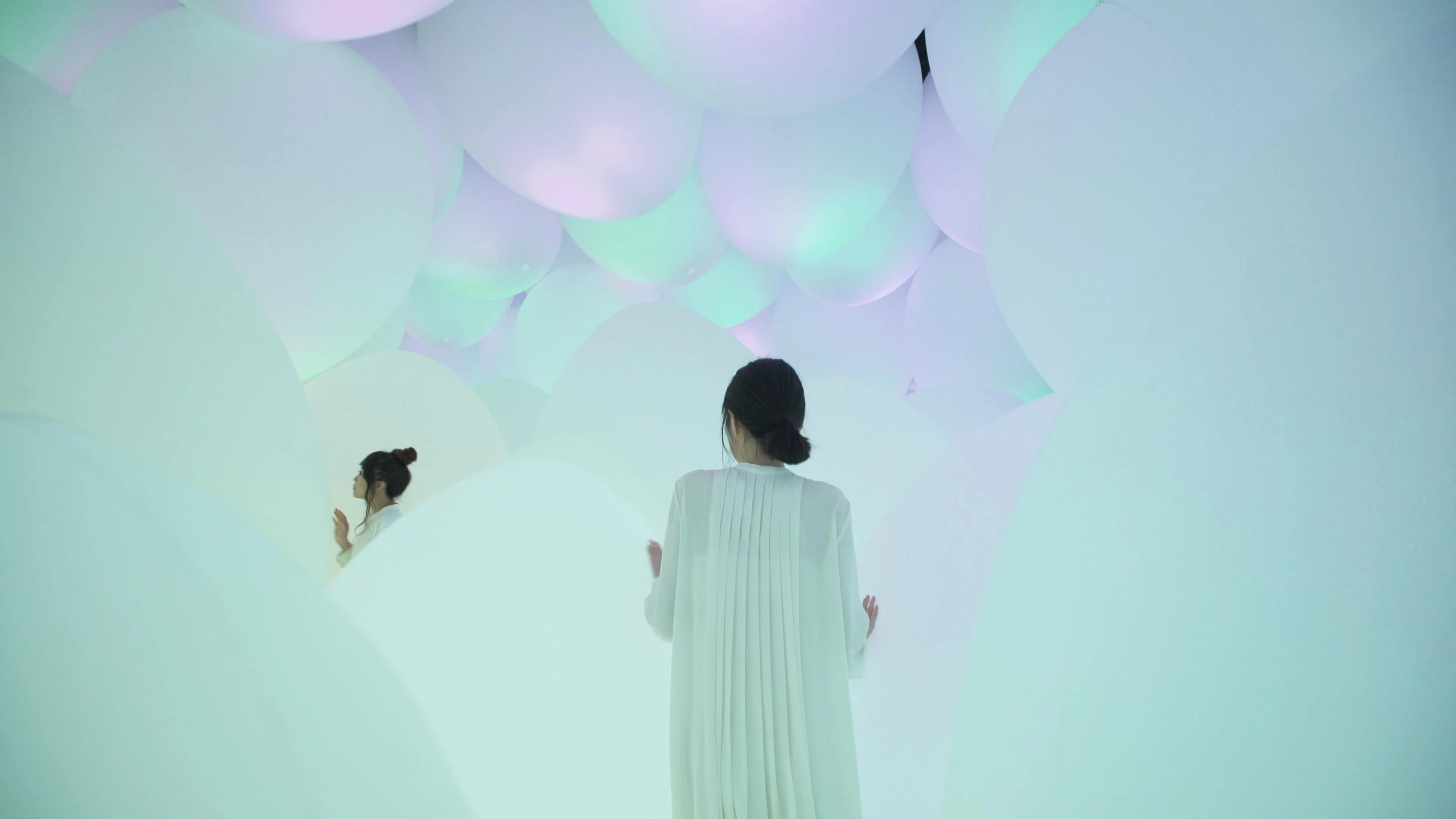
Weightless Forest of Resonating Life - Flattening 3 Colors and 9 Blurred Colors
teamLab, 2019, Interactive Digital Installation, Sound: Hideaki Takahashi
The space is filled with ovoids of light. People move through the ovoids and enter the space.
People recognize the multi-dimensionality of the space when the group of ovoids shine with various blurred colors, but the space feels flat when the ovoids are monochromatic. As the space changes between three dimensions and two dimensions, the whole body is immersed in both a three dimensional space and a flat plane.
When people strike the ovoids of light, it causes the color of the ovoid to change, and a tone specific to that color resonates out. The surrounding ovoids will respond, and the same color and tone will resonate radially throughout the space.
Each ovoid moves freely, but no matter where it is, the behavior of light is maintained across the entirety of the space. Therefore, the light behaves as a group and can be thought of as one three-dimensional existence. The light resonates out spherically across the space from the impacted ovoid. While recognizing the light’s three dimensional existence, people push through the ovoids to enter into that existence.
Since the ovoid colors are produced by light, it is possible to create 9 blurred colors (light in water, sunlight on water plants, morning glow, morning sky, sky at twilight, peach, plum, iris, and spring maple), as well as 3 colors that flatten the space (blue, red, and green), resulting in a total of twelve colors.
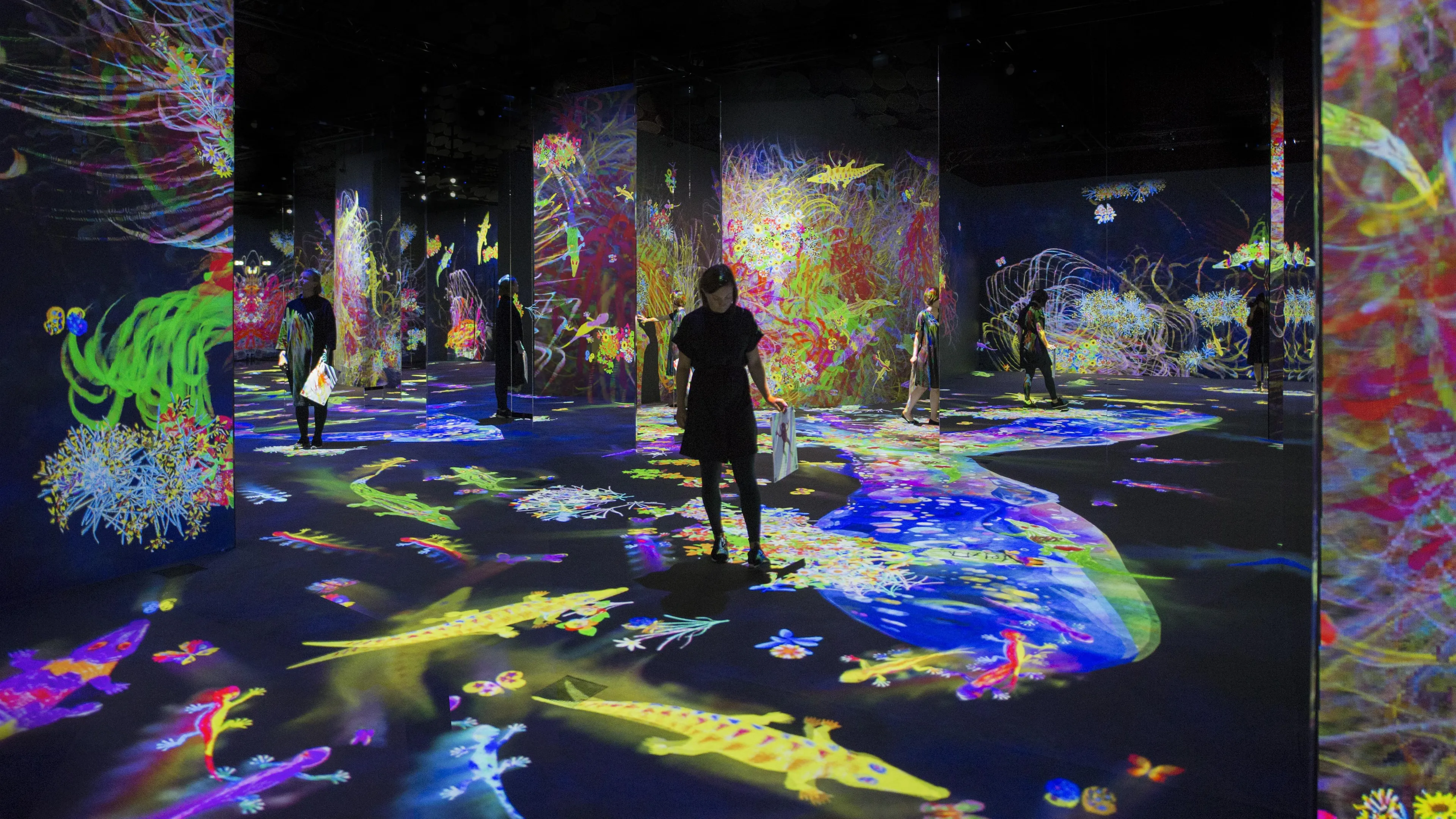
그래피티 네이처: 몰입 그리고 탄생 / Graffiti Nature: Lost, Immersed and Reborn
teamLab, 2018, Interactive Digital Installation, Sound: Hideaki Takahashi
사람들이 그린 다양한 생물들로 만들어가는 하나의 생태계. 당신이 그린 생물도 이 생태계 어딘가에 있다.
생물들은 다른 생물들을 잡아먹거나 잡아먹히며 함께 하나의 생태계를 만들어갑니다.
그림으로 태어난 생물은 다른 생물을 잡아먹으면 수가 늘어난다. 다른 생물에게 잡아먹히거나 다른 생물을 잡아먹지 못하면 죽어서 사라진다.
사람들이 움직이지 않으면 꽃이 늘어나지만, 반대로 밟으며 돌아다니면 지고 만다. 나비는 꽃이 있는 곳에서 늘어나며, 악어는 사람들에게 많이 밟히면 죽고 만다.
사람들은 타자와 함께 작품의 일부가 되어 녹아듦으로써 자신과 타자와의 경계를 연속적인 것으로 변화시키고,
우리들과 세계 간의, 경계가 존재하지 않는 새로운 관계를 모색한다.
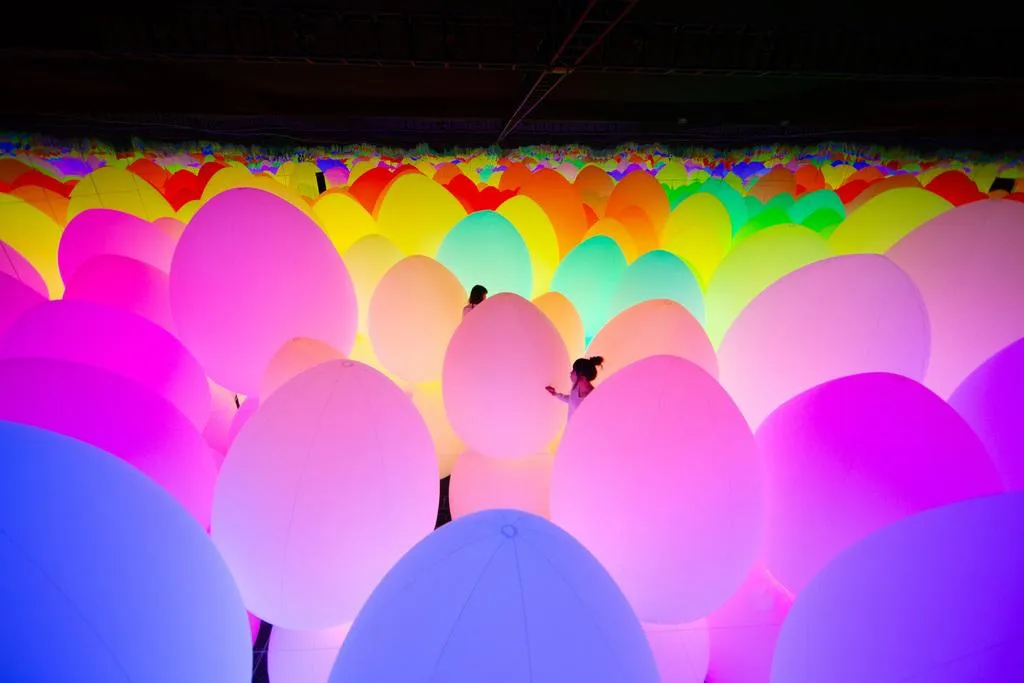
저항하고 공명하는 타원: 헤메이고, 빠져들고, 연속하다 / Resisting and Resonating Ovoids: Lost, Immersed and Continuous
teamLab, 2018, Interactive Installation, Endless, Sound: Hideaki Takahashi
공간은 여러 크기의 물체들로 가득 차있다. 사람들은 물체들의 사이를 헤집고 공간 속으로 들어간다.
저항하는 물체들은 사람들이 헤집거나 치는 등 충격을 가하면 색이 변화하며 소리를 퍼트린다. 그 주위의 있는 물체는 가까운 물체와 공명하며 같은 색, 같은 음을 퍼트린다.
저편에서 빛들이 퍼져오면 그것은 곧 저편에 사람이 있음을 의미한다. 사람들은 같은 공간에 있는 타인의 존재를 평소보다 더 의식하게 될 것이다.

